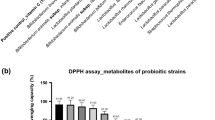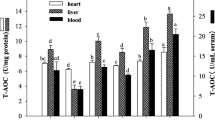Abstract
Purpose
In the present study, we systematically identified and evaluated a synbiotic combination of phytochemical epigallocatechin gallate (EGCG) and probiotic bacteria in amelioration of immunosenescence and oxidative stress in aged mice.
Methods
Inhibitory effects of EGCG against different bacterial species were evaluated in vitro, followed by analysis to identify potential combination of EGCG and probiotic bacteria against alleviation of oxidative and inflammatory stress ex vivo. The best synbiotic combination, vis-à-vis prebiotic and probiotic supplementation alone, was then evaluated in aged Swiss albino mice for modulation of various immunological and antioxidative parameters.
Results
EGCG strongly inhibited the growth of pathogenic microbes as compared to probiotic bacteria. A combination of EGCG with probiotic Lactobacillus fermentum (LF) provided evidence of additive effects in the amelioration of oxidative and inflammatory stress-induced cell death. In vivo study revealed that combined supplementation of LF and EGCG significantly enhanced neutrophil oxidative index, CD3+ cell numbers and activation status, Th1/Th2 cytokines in splenic supernatants as well as liver Nrf-2 expression in comparison with treatments with LF or EGCG alone. The combined application of EGCG and LF did not simply result in additive or synergistic effects in relation with individual treatments.
Conclusion
These observations suggest that EGCG could be considered as a potential prebiotic that can offer second generation synbiotic health beneficial effects for the alleviation of some of the deleterious aspects of immunosenescence and aging.









Similar content being viewed by others
Change history
28 June 2019
Authors of the original article have observed an inadvertent error in their manuscript post-publication.
Abbreviations
- EGCG:
-
Epigallocatechin gallate
- LF:
-
Lactobacillus fermentum
- LR:
-
Lactobacillus rhamnosus
- LP:
-
Lactobacillus planatarum
- tBHP:
-
Tert-Butyl hydroperoxide
- PRE:
-
Prebiotic
- PRO:
-
Probiotic
- SYN:
-
Synbiotic
- PBMCs:
-
Peripheral blood mononuclear cells
- PCM:
-
Probiotic-conditioned media
- NF-κB:
-
Nuclear factor kappa-light-chain enhancer of activated B cells
References
Aw D, Silva AB, Palmer DB (2007) Immunosenescence: emerging challenges for an ageing population. Immunology 120(4):435–446
Verburgh K (2015) Nutrigerontology: why we need a new scientific discipline to develop diets and guidelines to reduce the risk of aging-related diseases. Aging Cell 14(1):17–24
Sharma R, Kapila R, Kapila S (2013) Probiotics as anti-immunosenescence agents. Food Rev Int 29(2):201–216
Kerry RG, Patrab JK, Goudac S, Park Y, Shin HS, Das G (2018) Benefaction of probiotics for human health: a review. J Food Drug Anal. https://doi.org/10.1016/j.jfda.2018.01.002
Vodnar DC, Socaciu C (2012) Green tea increases the survival yield of Bifidobacteria in simulated gastrointestinal environment and during refrigerated conditions. Chem Cent J 6(1):61
Ampatzoglou A, Atwal KK, Maidens CM, Williams CL, Ross AB, Thielecke F, Jonnalagadda SS, Kennedy OB, Yaqoob P (2015) Increased whole grain consumption does not affect blood biochemistry, body composition, or gut microbiology in healthy, low-habitual whole grain consumers. J Nutr 145(2):215–221
Hollænder PL, Ross AB, Kristensen M (2015) Whole-grain and blood lipid changes in apparently healthy adults: a systematic review and meta-analysis of randomized controlled studies. Am J Clin Nutr 102(3):556–572
Bindels LB, Delzenne NM, Cani PD, Walter J (2015) Towards a more comprehensive concept for prebiotics. Nat Rev Gastroenterol Hepatol 12(5):303–310
Krumbeck JA, Maldonado-Gomez MX, Ramer-Tait AE, Hutkins RW (2016) Prebiotics and synbiotics: dietary strategies for improving gut health. Curr Opin Gastroenterol 32(2):110–119
Lee HC, Jenner AM, Low CS, Lee YK (2006) Effect of tea phenolics and their aromatic fecal bacterial metabolites on intestinal microbiota. Res Microbiol 157(9):876–884
Su P, Henriksson A, Nilsson C, Mitchell H (2008) Synergistic effect of green tea extract and probiotics on the pathogenic bacteria, Staphylococcus aureus and Streptococcus pyogenes. World J Microbiol Biotechnol 24:1837–1842
Sourabh A, Kanwar SS, Sud RG, Ghabru A, Sharma OP (2014) Influence of phenolic compounds of Kangra tea [Camellia sinensis (L) O Kuntze] on bacterial pathogens and indigenous bacterial probiotics of Western Himalayas. Braz J Microbiol 44(3):709–715
Banerjee A, Dhar P (2018) Amalgamation of polyphenols and probiotics induce health promotion. Crit Rev Food Sci Nutr. https://doi.org/10.1080/10408398.2018.1478795
Kumari M, Swarnkar MK, Kumar S, Singh AK, Gupta M (2015) Genome sequence of a potential probiotic strain, Lactobacillus fermentum HFB3, isolated from a human Gut. Genome Announc 3(6):e01296–e01315
Kumari M, Swarnkar MK, Kumar S, Singh AK, Gupta M (2015) Complete genome sequence of potential probiotic Lactobacillus sp. HFC8, isolated from human gut using PacBio SMRT sequencing. Genome Announc 3(6):e01315–e01337
Sharma R, Sharma A, Kumari A, Kulurkar PM, Raj R, Gulati A, Padwad YS (2017) Consumption of green tea epigallocatechin-3-gallate enhances systemic immune response, antioxidative capacity and HPA axis functions in aged male swiss albino mice. Biogerontology 18(3):367–382
Crowley LC, Scott AP, Marfell BJ, Boughaba JA, Chojnowski G, Waterhouse NJ (2016) Measuring cell death by propidium iodide uptake and flow cytometry. Cold Spring Harb Protoc 7:pdb.prot087163
Sharma R, Kapila R, Haq MR, Salingati V, Kapasiya M, Kapila S (2014) Age-associated aberrations in mouse cellular and humoral immune responses. Aging Clin Exp Res 26(4):353–362
Joyce JA, Pollard JW (2009) Microenvironmental regulation of metastasis. Nat Rev Cancer 9(4):239–252
Mair KH, Stadler M, Talker SC, Forberg H, Storset AK, Müllebner A, Duvigneau JC, Hammer SE, Saalmuller A, Gerner W (2016) Porcine CD3+NKp46+ lymphocytes have NK-cell characteristics and are present in increased frequencies in the lungs of influenza-infected animals. Front Immun 7:263
Pirson C, Engel R, Jones GJ, Holder T, Holst O, Vordermeier HM (2015) Highly purified mycobacterial phosphatidylinositol mannosides drive cell-mediated responses and activate NKT cells in cattle. Clin Vaccine Immunol 22(2):178–184
You J, Yaqoob P (2012) Evidence of immunomodulatory effects of a novel probiotic, Bifidobacterium longum bv. infantis CCUG 52486. FEMS Immunol Med Microbiol 66(3):353–362
Mahnke YD, Roederer M (2007) Optimizing a multicolor immunophenotyping assay. Clin Lab Med 27(3):469–485
Bradford MM (1976) A rapid and sensitive method for the quantitation of microgram quantities of protein utilizing the principle of protein-dye binding. Anal Biochem 72:248–254
Zhang X, Zhu X, Sun Y, Hu B, Sun Y, Jabbar S, Zeng X (2013) Fermentation in vitro of EGCG, GCG and EGCG3"Me isolated from Oolong tea by human intestinal microbiota. Food Res Int 54(2):1589–1595
Sharma R, Kapila R, Dass G, Kapila S (2014) Improvement in Th1/Th2 immune homeostasis, antioxidative status and resistance to pathogenic E. coli on consumption of probiotic Lactobacillus rhamnosus fermented milk in aging mice. Age (Dordr) 36(4):9686
Unno K (2016) Prevention of brain aging by green tea components: role of catechins and theanine. J Sports Med Phys Fit 5(2):117–122
Landete JM, Gaya P, Rodríguez E, Langa S, Peirotén Á, Medina M, Arqués JL (2017) Probiotic bacteria for healthier aging: immunomodulation and metabolism of phytoestrogens. Biomed Res Int. https://doi.org/10.1155/2017/5939818
Arena MP, Russo P, Capozzi V, Rascon A, Felis GE, Spano G, Fiocco D (2016) Combinations of cereal β-glucans and probiotics can enhance the anti-inflammatory activity on host cells by a synergistic effect. J Funct Foods 23:12–23
Roller M, Pietro Femia A, Caderni G, Rechkemmer G, Watzl B (2004) Intestinal immunity of rats with colon cancer is modulated by oligofructose-enriched inulin combined with Lactobacillus rhamnosus and Bifidobacterium lactis. Br J Nutr 92(6):931–938
Nikolich-Žugich J (2014) Aging of the T cell compartment in mice and humans: from no naive expectations to foggy memories. J Immunol 193(6):2622–2629. https://doi.org/10.4049/jimmunol.1401174
Jagger A, Shimojima Y, Goronzy JJ, Weyand CM (2014) Regulatory T cells and the immune aging process: a mini-review. Gerontology 60(2):130–137
Smelt MJ, de Haan BJ, Bron PA, van Swam I, Meijerink M, Wells JM, Faas MM, de Vos P (2013) Probiotics can generate FoxP3 T-cell responses in the small intestine and simultaneously inducing CD4 and CD8 T cell activation in the large intestine. PLoS One 4(7):e68952 8(
Lutz CT, Moore MB, Bradley S, Shelton BJ, Lutgendorf SK (2005) Reciprocal age related change in natural killer cell receptors for MHC class I. Mech Ageing Dev 126:722–731
Le Garff-Tavernier M, Béziat V, Decocq J, Siguret V, Gandjbakhch F, Pautas E, Debré P, Merle-Beral H, Vieillard V (2010) Human NK cells display major phenotypic and functional changes over the life span. Aging Cell 9(4):527–535. https://doi.org/10.1111/j.1474-9726.2010.00584.x
Lutz CT, Karapetyan A, Al-Attar A, Shelton BJ, Holt KJ, Tucker JH, Presnell SR (2011) Human NK cells proliferate and die in vivo more rapidly than T cells in healthy young and elderly adults. J immunol 186:4590–4598
Hazeldine J, Hampson P, Lord JM (2012) Reduced release and binding of perforin at the immunological synapse underlies the age-related decline in natural killer cell cytotoxicity. Aging Cell 11:751–759
Zhang Y, Wallace DL, de Lara CM, Ghattas H, Asquith B, Worth A, Griffin GE, Taylor GP, Tough DF, Beverley PC, Macallan DC (2007) In vivo kinetics of human natural killer cells: the effects of ageing and acute and chronic viral infection. Immunol 121:258–265
Solana R, Alonso MC, Peña J (1999) Natural killer cells in healthy aging. Exp Gerontol 34(3):435–443
Tymoshok NO, Lazarenko LM, Bubnov RV, Shynkarenko LN, Babenko LP, Mokrozub VV, Melnichenko YA, Spivak MY (2014) New aspects the regulation of immune response through balance Th1/Th2 cytokines. EPMA Journal 5(Suppl 1):A134
Tilstra JS, Clauson CL, Niedernhofer LJ, Robbins PD (2011) NF-κB in aging and disease. Aging Dis 2(6):449–465
Zhang H, Davies KJA, Forman HJ (2015) Oxidative stress response and Nrf2 signaling in aging. Free Radic Biol Med 88(Pt B):314–336
Xu J, Jönsson T, Plaza M, Håkansson Å, Antonsson M, Ahrén IL, Turner C, Spégel P, Granfeldt Y (2018) Probiotic fruit beverages with different polyphenol profiles attenuated early insulin response. Nutr J 17(1):34
Krautkramer KA, Rey FE, Denu JM (2017) Chemical signaling betweengut microbiota and host chromatin: what is your gut really saying? J Biol Chem 292(21):8582–8593
Wang Y, Liu Y, Sidhu A, Ma Z, McClain C, Feng W (2012) Lactobacillus rhamnosus GG culture supernatant ameliorates acute alcohol-induced intestinal permeability and liver injury. Am J Physiol Gastrointest Liver Physiol 303(1):G32–G41
Seenappanahalli Nanjundaiah Y, Wright DA, Baydoun AR, O’Hare WT, Ali Z, Khaled Z, Sarker MH (2016) Lactobacillus rhamnosus GG conditioned media modulates acute reactive oxygen species and nitric oxide in J774 murine macrophages. Biochem Biophys Rep 7:6:68–75
Acknowledgements
Authors acknowledge the Director, CSIR-IHBT, Palampur for supporting and providing all the necessary facilities. This work was supported by grants from the Science and Engineering Research Board, Government of India, through the Young Scientist Scheme (YSS/2015/000758) and MLP0204 of CSIR Government of India.
Author information
Authors and Affiliations
Corresponding authors
Ethics declarations
Conflict of interest
On behalf of all authors, the corresponding author states that there is no conflict of interest.
Electronic supplementary material
Below is the link to the electronic supplementary material.
Rights and permissions
About this article
Cite this article
Sharma, R., Kumari, M., Kumari, A. et al. Diet supplemented with phytochemical epigallocatechin gallate and probiotic Lactobacillus fermentum confers second generation synbiotic effects by modulating cellular immune responses and antioxidant capacity in aging mice. Eur J Nutr 58, 2943–2957 (2019). https://doi.org/10.1007/s00394-018-01890-6
Received:
Accepted:
Published:
Issue Date:
DOI: https://doi.org/10.1007/s00394-018-01890-6




